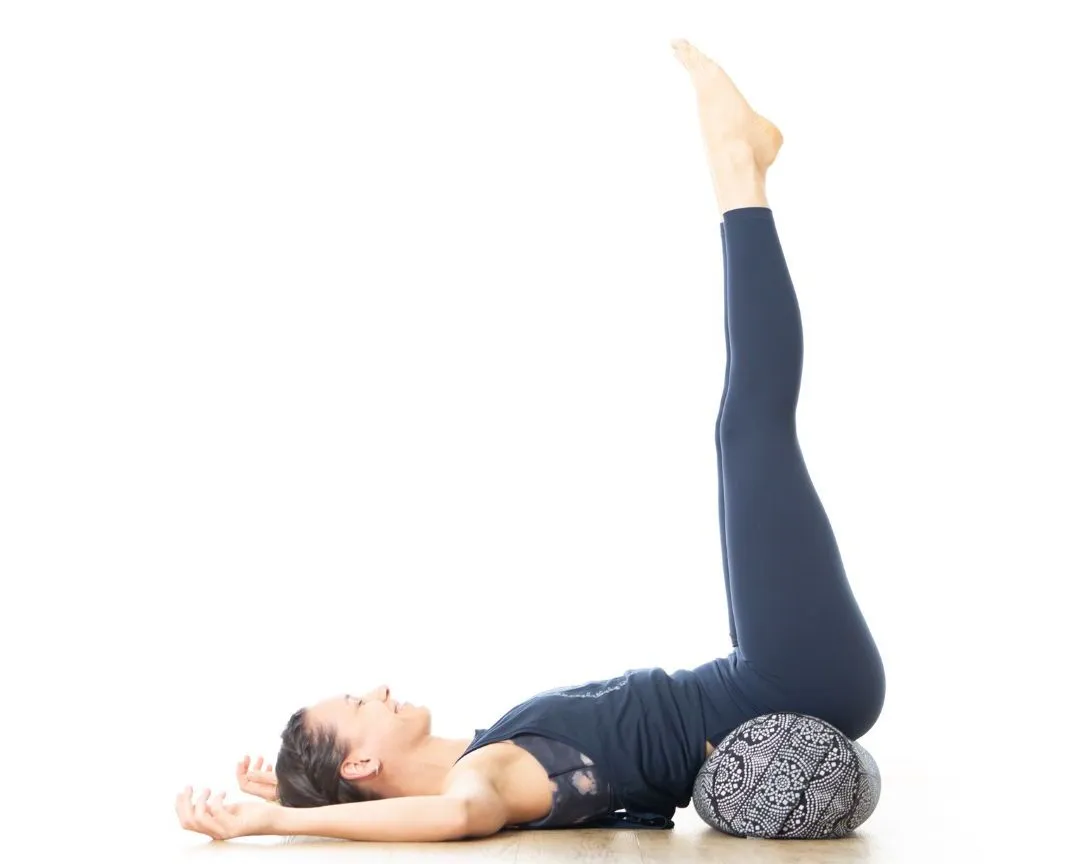The Ultimate Guide to Restorative Yoga: A Deeply Relaxing Practice for All Levels

Are you looking for a yoga practice that can help you deeply relax and rejuvenate? Look no further than restorative yoga! In The Ultimate Guide to Restorative Yoga: A Deeply Relaxing Practice for All Levels, you’ll discover the benefits of this gentle practice, as well as tips and tricks for getting the most out of your practice, no matter your skill level.
Restorative yoga is a deeply relaxing and supportive practice that uses props like blankets, bolsters, and blocks to help you release tension and let go of stress while you hold poses. This practice is perfect for anyone looking to unwind, whether you’re recovering from an injury or illness, dealing with chronic pain, or simply looking for a way to reduce stress and improve your overall well-being.
In this comprehensive guide, we’ll explore the foundations of restorative yoga, including key poses and breathing techniques, as well as tips for creating a peaceful and supportive practice space.
So whether you’re a seasoned yogi or just starting out, join us as we delve into the world of restorative yoga and discover the ultimate path to relaxation and renewal. Also, see our article explaining the top Yoga Practices!
What is Restorative Yoga?
Restorative yoga, also known as gentle yoga, is a type of yoga that is crafted to pacify, revive, and re-energize the physique, psyche, and essence. Restorative yoga is part of the extensive field of hatha yoga, a primeval form of yoga originating in India, which is designed to extend and reinforce the physical body in anticipation of seated meditation.
During a restorative yoga session, you will encounter mild actions, elongated postures frequently sustained with bolstering objects such as blankets and blocks, and a collective ambiance of tranquility and serenity.
Positions can be held for varying periods, from two to 20 minutes. While restorative yoga is occasionally conflated or confused with yin yoga, the methodologies contrast. In the yin yoga tradition, the aim is to stretch into the profound layers of the anatomy through sustained postures that put a minute, intentional amount of tension on the body.
Benefits of Restorative Yoga Today
Restorative yoga helps with a wide range of benefits for the body and mind. Some of the most significant benefits include:
Reduced stress and anxiety: Restorative yoga can help you to reduce stress and anxiety by relaxing the body and mind.
Better sleep: Restorative yoga can help you to improve your sleep quality by promoting relaxation and reducing stress.
Improved flexibility: Restorative yoga can help you to improve your flexibility by gently stretching and releasing tension in the muscles.
Reduced pain: Restorative yoga can help you to reduce pain in the body, including chronic pain and injuries.
Improved mood: Restorative yoga can help you to improve your mood by promoting deep relaxation and reducing stress.
Use of Props in Restorative Yoga
Props can serve as a supporting element in your restorative yoga practice, enhancing comfort and further deepening the relaxation you experience during poses. The support they provide can allow your body to achieve a higher level of relaxation, allowing your nervous system to enter a state of rest.
When your nervous system is calm, your mind and body can refresh and restore, enabling you to present the best version of yourself to those around you, including your family, friends, coworkers, and society.
Consider incorporating the following props into your restorative yoga practice. Whenever possible, select props made from eco-conscious materials that are recycled or organic.
Yoga Mat: Choose a yoga mat that is pliable for your restorative yoga practice. You may even choose to place a blanket over the entire mat to add extra warmth and cushioning.
Blankets: Use a blanket that can offer weight, warmth, and cushioning for your practice. Mexican blankets are a common prop utilized in yoga studios.
Yoga Blocks: Yoga blocks can be made from cork, wood, or recycled foam. You may also utilize a stack of books as blocks when practicing at home.
Bolsters: Bolsters are large, stiff pillows that provide additional support during restorative poses. They are available in rectangular, round, or alternative shapes.
Eye Pillow: An eye pillow is a small rectangular cushion typically filled with flaxseed or sand. These pillows usually include dried lavender flowers for their soothing aromatherapeutic properties.
These restorative yoga poses may be practiced alone, in a sequence, or in any order that meets your needs. Incorporate these poses into your routine as frequently as possible, ideally on a daily basis, or at minimum, once a week for maximum benefit.
Restorative Yoga Poses
Restorative poses are designed to be held for extended periods, typically between 5 to 20 minutes. Here are some of the key restorative yoga poses to try:
Child’s Pose (Balasana) With Support: Child’s Pose is a gentle yoga pose that can help you relax your lower back, stretch your knees, and feel grounded overall. To perform Child’s Pose, you’ll need two blankets and a bolster.

Supported Bridge Pose (Setu Bandha Sarvangasana): Supta Badha Konasana, also known as Reclining Bound Angle Pose, is a yoga pose that can help you relax your back, stretch your hips and groins, and feel grounded overall. To perform Supta Badha Konasana, you’ll need two blocks and two blankets.
Reclined Twist (Supta Matsyendrasana) With Support: Supported Matsyasana, or Fish Pose, is a yoga pose that can help you open your chest and shoulders, relax your upper back, and feel energized overall. To perform Supported Matsyasana, you’ll need two blocks.

Supported Legs-Up-the-Wall Pose (Viparita Karani): Legs Up the Wall is a yoga pose that can help you alleviate stress, reduce anxiety, and improve circulation. To perform Legs Up the Wall, you’ll need a wall and a bolster or folded blanket.
This pose is great for improving circulation in the legs and reducing swelling in the feet and ankles.

Supported Corpse Pose (Savasana): Savasana, or Corpse Pose, is a pose of total relaxation that can help you reduce stress and tension in your body and mind. Adding support to this pose can help you relax even more deeply holding poses for longer. To perform Supported Savasana, you’ll need a bolster, a blanket, and an eye pillow.
Incorporating these restorative yoga poses into your regular practice can help you reduce stress, alleviate pain, and promote overall well-being. Remember to take your time and adjust the poses to your own comfort level, using props as needed to support your body. With practice, these poses can help you achieve deeper relaxation and rejuvenation.
What to Expect in a Restorative Yoga Class
In a restorative yoga class, you can expect a slow and gentle practice with a focus on relaxation and release. The teacher will provide you with the props you need for the class and guide you through each pose. You may only do four or five poses over the course of an entire class, with each pose held for several minutes at a time.
The yoga teacher may play soft ambient music and dim the lights to create a calming and relaxing atmosphere. Some teachers may also incorporate guided meditations or breathing exercises into the class. The goal of the class is to help you to slow down, relax, and release tension in the body and mind.
Restorative yoga is a restorative practice that can benefit people of all levels and backgrounds. It is a gentle and calming practice that can help you to reduce stress, improve your sleep, and increase your overall sense of well-being. If you’re looking for a way to slow down and take a break from the fast-paced world we live in, restorative yoga may be just what you need.
Tips for Practicing Restorative Yoga
Restorative, Vinyasa, and Yin Yoga: Which Practice Is Right for You?
For those looking to delve into the world of yoga, there are many different styles to choose from. Three of the most popular practices are restorative yoga, vinyasa yoga, and yin yoga, each offering its unique benefits and characteristics.
Restorative yoga is a slow and gentle practice that is perfect for anyone looking to unwind and reduce stress. The focus is on deep relaxation and rejuvenation, using props like blankets, bolsters, and blocks to support the body in different poses. With this style, you will hold each pose for an extended period, allowing you to sink deeply into the stretch and release tension from your muscles.
Vinyasa yoga, on the other hand, is a more active and flowing form of yoga that focuses on linking breath with movement. This practice offers a great workout and is ideal for building strength, flexibility, and endurance. With each breath, you will move seamlessly from one pose to the next, creating a continuous flow that leaves you feeling energized and invigorated.
Finally, yin yoga is a slow-paced practice that involves holding passive poses for several minutes to stretch the connective tissues in the body. It’s perfect for anyone looking to increase flexibility and mobility and is especially helpful for athletes and those with tight muscles. With this style, you will hold each pose for a longer time, allowing your muscles to relax and lengthen slowly.
Choosing the right practice for you depends on your goals and preferences. If you’re looking to relax and reduce stress, restorative yoga is a great choice. If you want to get a good workout and build strength and flexibility, vinyasa yoga might be a better fit. And if you want to increase your flexibility and mobility, yin yoga is the way to go.
Ultimately, the best way to find out which style of yoga is right for you is to try them all and see which one resonates with you the most. So, roll out your mat and explore these practices, and you’ll soon find the perfect yoga style for you!
Conclusion
As I bring this guide to a close on the topic of restorative yoga, I am amazed at the power of this gentle practice. The utilization of supportive props and extended holds within each pose has proven to effectively release tension and stress within the body and mind. It is truly remarkable that a practice that involves minimal movement can have such a profound impact on one’s overall well-being.
Restorative yoga is the type of yoga that provides a wide range of benefits including improved sleep, reduced stress and anxiety, increased flexibility, reduced pain, and improved mood. It is fascinating that such a gentle and passive practice can have such positive effects on both physical and mental health.
I highly recommend trying restorative yoga if you are seeking a way to slow down and take a break from our fast-paced world. This practice can be beneficial for anyone regardless of age, fitness level, or yoga experience. Take a moment to indulge in this deeply relaxing and calming practice and see for yourself the transformation it can bring to your body and mind.



